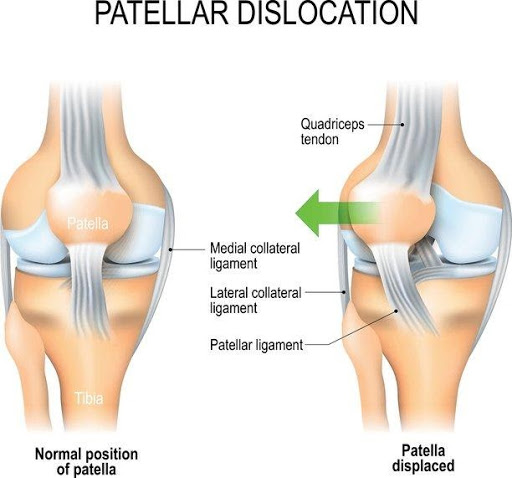Patella dislocation refers to the displacement of the knee cap out from its normal alignment from the groove of the femur (thigh bone). Most commonly, the patella tends to dislocate laterally towards the outside of the knee. As muscles, ligaments and stabilizing structures run through the knee joint, a dislocation can therefore disrupt these structures and cause them to be overstretched and damaged.

What causes patella dislocation?
Dislocation of the kneecap is often caused by a traumatic type incident, such as a direct blow to the knee in a twisting motion. However, there are also factors that can increase the risk of patella dislocation, such as:
- Previous history of patella dislocation or subluxation
- Poor tracking of the patella
- Shallow femoral groove
- Weak inner quadriceps muscles
- Tight lateral muscles/support, such as vastus lateralis (lateral part of the quadriceps), ITB, hip flexors and biceps femoris (lateral part of the hamstring)
Symptoms include:
- Visible relocation of the kneecap to outside of the knee
- Swelling and tenderness at the kneecap
- Pain in weight bearing or straightening of the leg
- Feeling of instability, like it is giving way
- Feeling of weakness in the quadriceps muscles
This injury is usually seen in athletic teenagers participating in sports involving a lot of twisting and turning motions. Pivoting your femur (thigh bone) internally on a planted foot while knee is bent is the most common mechanism of injury (Greiwe et al., 2010).
Relocation of the patella will be needed, either by self or by health professional. X-rays, ultrasound or MRI may be used to confirm diagnosis. Damaged structures can also be identified on imaging, but this will also be assessed in the physiotherapy session.
What can physio do for patella dislocations?
The first step is to reduce the swelling and inflammation as well as providing some temporary support such as taping or bracing. Normalizing and improving the range in which your knee moves will be the major focus during this period. Once everything has settled, a rigorous rehab program focusing on strengthening muscles of the lower limbs begins. This type of training takes at least 8-12 weeks to 6 months of regular physio visits and adherence to the program for the best results to prevent future dislocations and for safe return to sports and daily activities.
Here at Capital Physiotherapy, we believe early management and rehabilitation is essential, so if this has happened to you or you notice you are experiencing some of the symptoms listed and need further advice, contact us today at info@capitalphysiotherapy.com.au or call 0401 865 333. We are located conveniently at South Yarra, Balwyn and Footscray.

